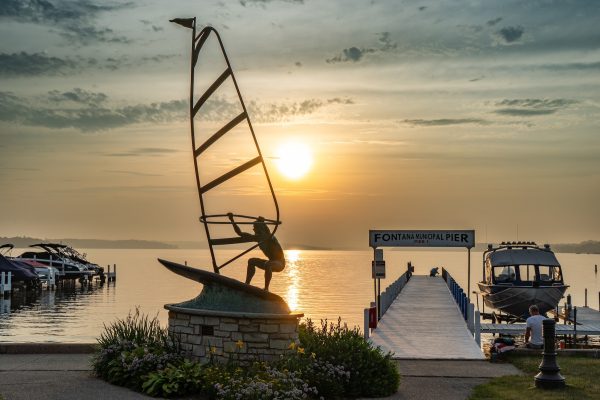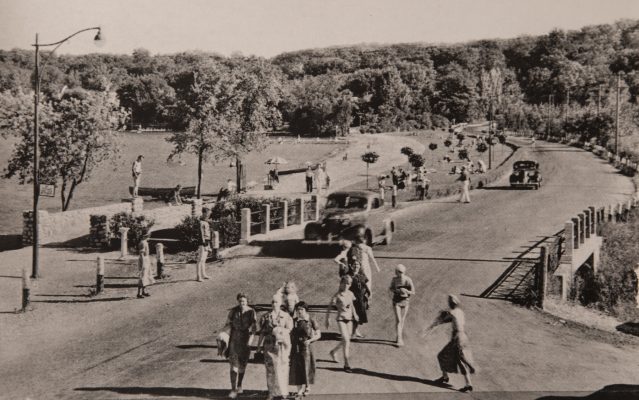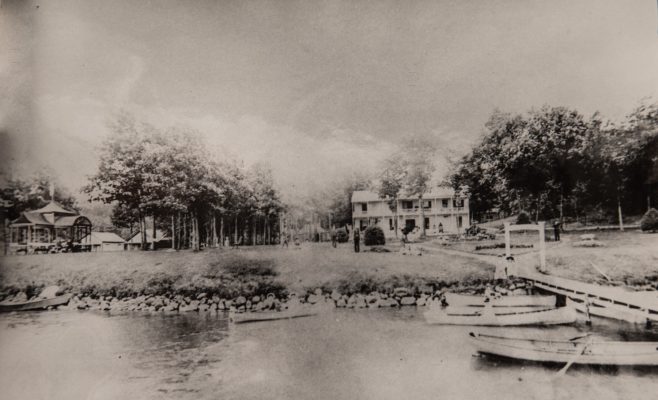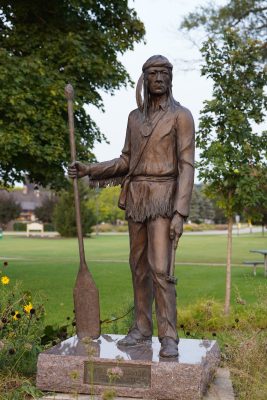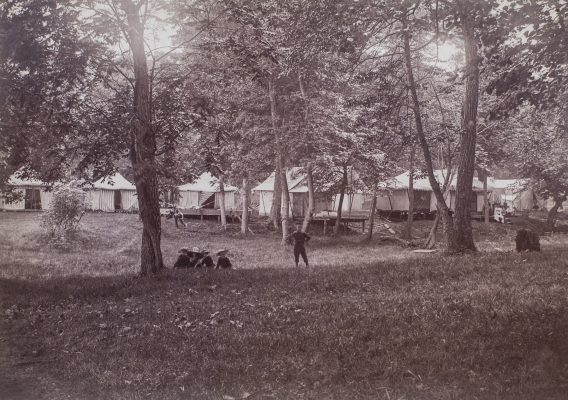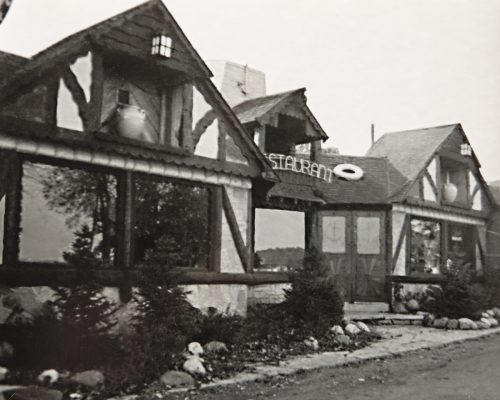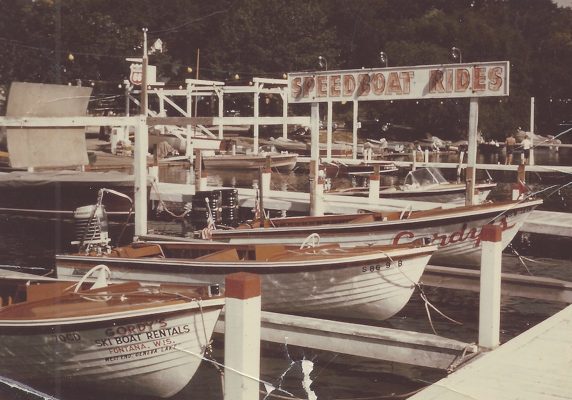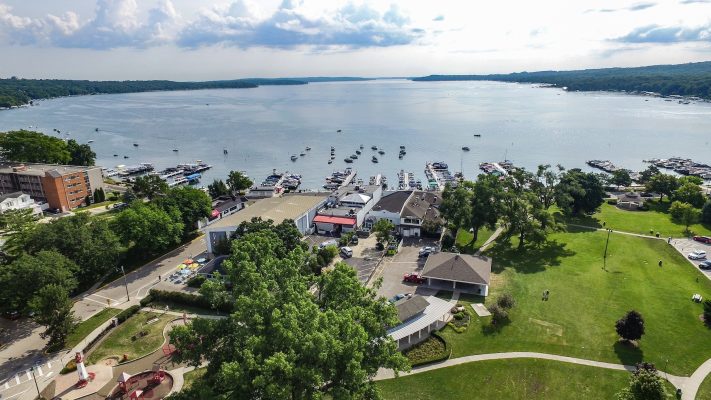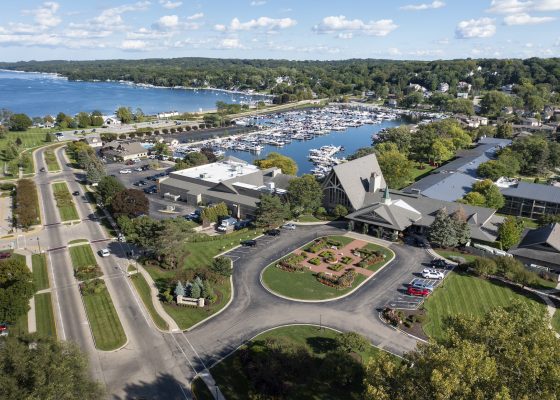By Anne Morrissy | Photography as noted
On April 15, 1924, more than 100 people packed into Fontana’s Woodman Hall (near the intersection of modern-day Mill St. and Fontana Ave.) for a very important town meeting. Just two weeks earlier, an election had been held for the leadership positions in the Town of Walworth, which at that time still contained within its borders the village of Fontana. The Fontana residents had put up several candidates in the election in the hopes of having their village’s concerns and priorities addressed, but all of their candidates had been trounced. Acknowledging their defeat at the polls, the villagers immediately decided to try a new tactic: incorporating as an independent village. The meeting that night was the first step toward this goal.
Following the meeting’s presentation, the organizers asked the attendants to sign a petition requesting the committee to “incorporate said proposed village on our behalf.”
More than 130 people signed the petition. The corresponding vote after the discussion was “practically unanimous” in favor of incorporation. It would take a few more months, but by mid-September of 1924, the Village of Fontana became its own, independently governed town.
“THIS CHARMING LANDSCAPE”
The area that made up the newly incorporated Village of Fontana was in fact one of the oldest inhabited areas on Geneva Lake. As early as 1695, a Potawatomi village had stood at the lake’s west end, stretching from what is now part of the Buena Vista subdivision south to Reid Park. That Native American village contained a main council house which served as the home of the chief, and a cluster of round and square huts that extended for about a quarter of a mile along the shoreline.
In the spring of 1831, John Kinzie and his wife, Juliette, passed through the area on their way from Chicago back to their home in Portage, where Kinzie served as the federal government’s Indian Agent. Juliette Kinzie wrote about their journey and her impressions of what came to be known as “Chief Big Foot’s Village”:
On a rising ground at the foot of one of the bold bluffs in the middle distance, a collection of neat wigwams formed, with their surrounding gardens, no unpleasant feature in the picture… a howl of delight bursting involuntarily from the whole party as this charming landscape met our view.
However, just two years later in 1833, the Potawatomi signed the Treaty of Chicago, which led to their removal to Kansas by the United States government. (A bronze statue in modern-day Reid Park by local artists Jay and Barbara Brost entitled “One Last Glance” commemorates the sad occasion of Chief Big Foot’s departure from Geneva Lake.) By 1837, the first white settlers arrived in the area and began establishing claims on the land. They chose the name Fontana (“fountain” in Italian) for their small enclave, presumably due to the prevalence of natural springs at the lake’s west end.
“PALACES FOR SUMMER RESORT SHALL YET RISE”
The small settlement of Yankee pioneers grew slowly throughout the second half of the 19th century, centered around the small downtown area near Main St. and Mill St. A handful of tent campers also discovered the charms of the lake’s west end, creating several tourist camps in Fontana for summer vacations: Harvard Camp (later Harvard Club), Montague & Porter’s Park and Forest Glen Resort among them. Despite this, the area remained mostly undeveloped, a result of the lack of a train line or other easy transportation options to the area. Historian James Simmons, writing in 1897, described Fontana as a still-rustic place: “Although [the] years have done very little toward developing this embryo village, we hazard nothing in predicting that palaces for summer resort shall yet rise beneath its cool shades and in the vicinity of its babbling brooks and crystal springs…” His words were impressively prescient.
With the arrival of an electric trolley line from Harvard, Illinois, in 1899 and a branch of the Chicago, Milwaukee and St. Paul Railroad in 1901, Fontana quickly became a hot spot for more permanent developments. Between the 1890s and the 1910s, many former tent camping sites became subdivisions of summer cottages, including Buena Vista Park, Belvidere Park and Glenwood Springs. Beginning around 1910, the proliferation of the automobile brought more and more people who would discover the beauty of Fontana-on-Geneva Lake and then decide to make a home there, whether permanently or in the summers only.
THE “COUNTRY CLUB” SET
One year prior to the vote to incorporate as a village in 1924, a group of 20 prominent citizens from Fontana, Walworth and Harvard joined forces to purchase a large tract of land on Fontana’s lakefront south and west of Glenwood Springs. The 690-acre property had previously belonged to Levi Z. Leiter, a Chicago businessman and former partner of Marshall Field’s. Leiter’s main home, Linden Lodge, was located on the lake’s east end in what is now the Lake Geneva Manor subdivision, but Leiter also owned this property on the west end, which he used as a farm and fish hatchery, making use of several natural springs, brooks and ponds. The property made up about 40 percent of the original acreage of Fontana. When Leiter passed away in 1904, ownership transferred to a trust supporting his wife and their adult children, but by the early 1920s, the Leiter family was eager to sell their Geneva Lake holdings.
By combining funds, these 20 investors formed the Geneva Lake Improvement Association. After working out an agreement to acquire the Leiter Farm, the association agreed to use 220 acres of the land to create a golf club, which eventually came to be known as the Big Foot Country Club. On a portion of the remaining acreage of the former Leiter farm, real estate developer Arthur B. Jensen sold home-building lots in a subdivision he named Country Club Estates. Leaders of the investor group maintained control of 90 acres of the property and access to the lake along the 1,100-foot frontage on the public road to ensure their vision of a residential community unspoiled by commercial development.
“Fontana would not have become the crown jewel of Geneva Lake as a successful residential community 100 years later but for the vision and courage of the group of citizens who gained control of the Leiter Estate property,” explains historian James Reynolds, author of the forthcoming book The Fontana Story. “They also bought out the lakefront dance hall and deeded it to the Village in a bargain sale. Their legacy is a beautiful beach, public parking and Reid Park.”
“A MILLIONAIRE’S THRILL”
Although the Great Depression and World War II slowed development in Fontana, by the post-war years, the area saw an influx of young families looking to establish roots here or invest in summer homes. One such visionary with a young family in the post-war years was Gordon “Gordy” Whowell, who bought a home in Indian Hills in 1945 and opened a small business offering speedboat rides at the lakefront in Fontana, with the tagline, “A Millionaire’s Thrill for One Thin Bill.” That modest business would eventually blossom into a family-run business empire that continues in Fontana today.
“[Gordy] believed in the future of the recreation industry in Fontana and high-quality service,” explains Tom Whowell, Gordy’s son who now runs the Gordy’s family of businesses in Fontana. “An entrepreneur, restaurateur, philanthropist … Gordy was an individual, but he has been aggrandized into a larger-than-life figure.”
Businesses along Fontana’s lakefront area came to define the village for the new “Baby Boom” generation: Meier’s Drive-In, Gordy’s Boat Rentals (later Gordy’s Lakefront Marine, Gordy’s Pro Shop, Gordy’s Boat House and Gordy’s Bait Shop), and popular bars Beachroamers Inn and Chuck’s Lakeshore Inn drew a young, trendsetting crowd of locals and visitors to Fontana.
Then, in 1963, a group of investors built The Abbey Resort in Fontana. The full-service resort was the largest in the Midwest at that time, and one of the most luxurious. Its distinctive A-frame architecture, designed by A. Epstein and Son architects, won a national design award sponsored by the National Lumber Manufacturers Association. When The Abbey opened, the 90-acre resort included a 225-room hotel, convention facilities for groups of up to 500 people, a fine dining restaurant headed by a French- trained chef, a casual restaurant, a café and cocktail lounges, as well as several recreation areas and indoor and outdoor swimming pools.
Developers of The Abbey had also undertaken a new marina project, converting what had been Van Slyck Creek and the natural springs and some of the pools of the Leiter Farm fish hatchery into The Abbey Marina, a 20-acre manmade harbor with mooring for up to 250 boats, including large yachts. The presence of The Abbey Resort and Marina established Fontana as a premier vacation destination for discerning travelers.
MARKING THE 100TH ANNIVERSARY
Today, 100 years after that group of villagers sat in Woodman’s Hall and voted to pursue incorporation, the Village of Fontana boasts a population of around 1,800 year-round residents and a summer population that may be many times higher than that.
To celebrate the centennial, village leaders have been marking the anniversary with a series of events over the past year, including an Oktoberfest celebration, a holiday tree lighting and Fontana Winterfest in February. Festivities will continue in support of all of the annual Fontana celebrations in 2024 — including the Fontana Garden Club Fair, the Lobster Boil & Steak Fry and the Fontana Triathlon, among others — and include a special centennial closing dinner as well. In addition, the centennial committee plans to reintroduce the “Music in the Park” series, with six free concerts this summer.
To honor the first 100 years of Fontana, last fall the centennial committee members also released Finding Fontana, a new coffee table book featuring full-color photography and historic images of Fontana throughout the past century. The book is available at local retailers including the Fontana Public Library and Fontana Home.
For those looking for a deeper dive into the village’s history, historian Reynolds will soon publish The Fontana Story, which chronicles the details of the village’s history from its earliest days through 1940.
“We villagers love it here,” explains centennial committee member and Finding Fontana editor Margaret Reuland. “Those who came before made it a priority to protect and conserve the abundant natural gifts they found, and to support their neighbors whenever needed. That ‘Fontana Spirit’ will continue as our community celebrates what was, and what will be moving forward.”

